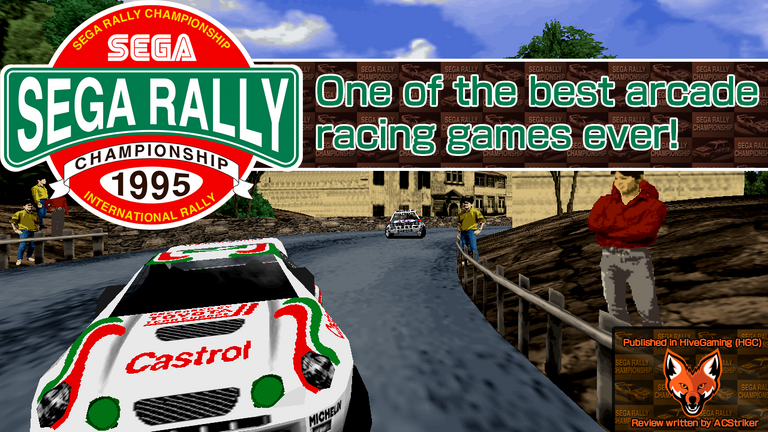
This post is avaliable in both English and Spanish. All screenshots captured by me. Spanish translation done with DeepL translator.
If you want to read it in English, just scroll below. If you want to read it in Spanish, press CTRL+F and type "-ESP-" (without quotes) on the bar that shows up to get to the Spanish version immediately. Alternatively, just keep scrolling down until the end of the English section.
Este post está disponible en ambos Inglés y Español. Todas las capturas fueron tomadas por mi. Traducción al español hecha con DeepL translator.
Si quieres leerlo en inglés, solo sigue abajo. Si quieres leerlo en español, presiona CTRL+F y escribe "-ESP-" (sin comillas) en la barra que aparece para llegar a la versión en Español inmediatamente. Alternativamente, solo sigue bajando hasta el final de la sección en Inglés.
English
I always had a soft spot for SEGA racing arcade games, considering Daytona USA 2 was the first one I saw as a kid on my local mall and getting instantly caught by it, then looking up about all the other games SEGA had put out. One of these would be the eponymous SEGA Rally Championship, known as one of their best masterpieces in this area along with Daytona USA and OutRun.
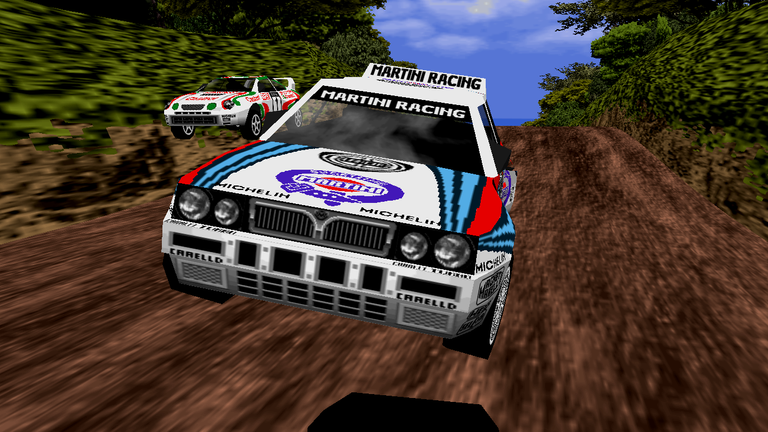
Featured in the same Model 2 arcade hardware used for Daytona USA, SEGA Rally Championship released in 1994 for Arcades and happened to be next in the unusual trend of SEGA racing games with licenses being very succesful (OutRun had the Ferrari, Daytona USA had the name, and this game featured real cars Toyota Celica GT-Four and Lancia Delta HF Integrale).
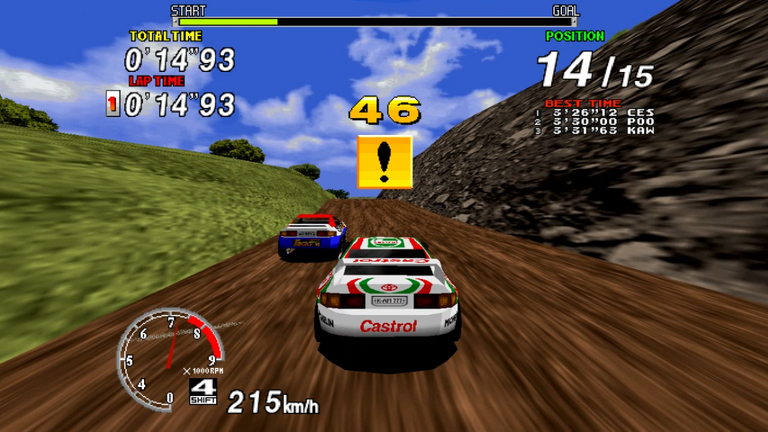
The game had 3 looping tracks (plus a hidden 4th one) and two modes: Championship, here you have to do one lap through all three tracks (plus the extra Lakeside track), and Practice, where you do three laps on the track of choice (with the Lakeside track being selectable through a button combo). Championship feels like a fresh take as you get to play through every track in a single credit/run, while Practice lets you test your time attack skills in a specific track.
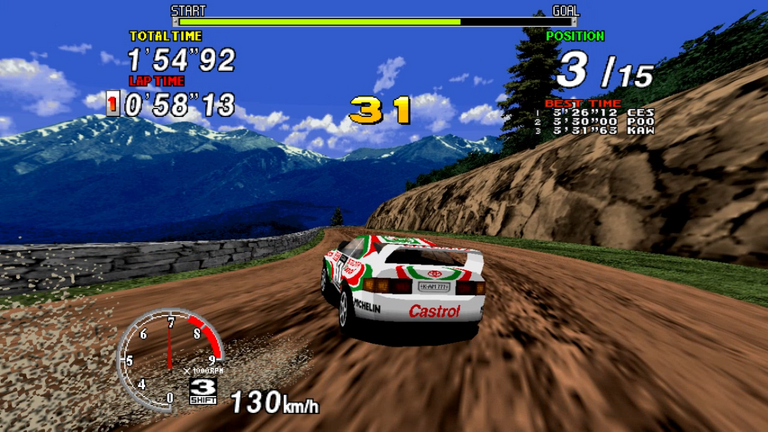
The gameplay is spot-on for an arcade game, and each terrain has different driving traction which was completely unheard of for its time. Easy to learn but hard to master, the handling is lenient enough to have a blast on the Desert and Mountain course, but you have to employ drifts for medium turns, K-turns and hairpins as there's a time limit pressuring you to finish. If you haven't got used to the game yet, you will probably run out of time at the Mountain track until you practice enough.
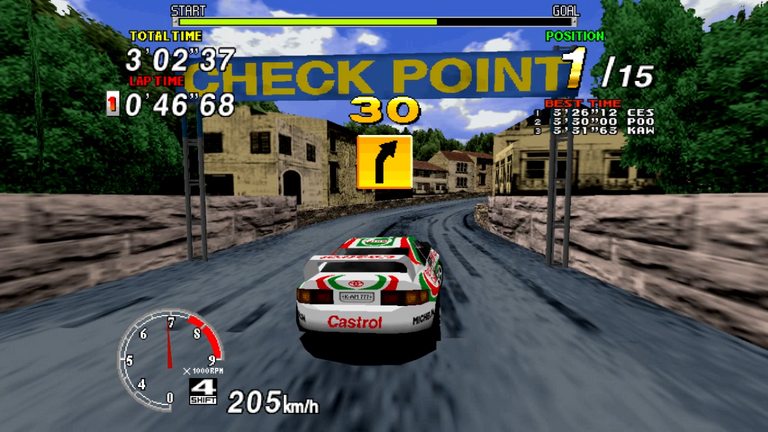
Speaking of practice, the Lakeside track mentioned before can only be accessed if you end with 1st place on the last track, and will put to test both your precision with the steering wheel and your patience with the gas pedal to keep a steady speed but avoiding to bump with the quite thin borders of the track.
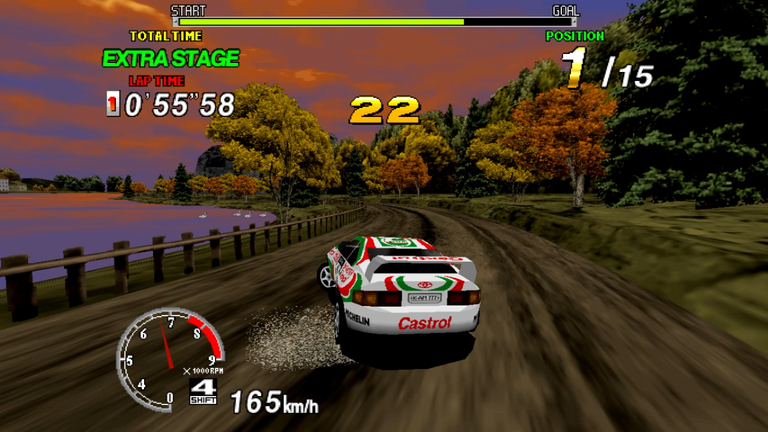
Paired with the stunning graphics for the time (which still hold up well when upscaled) and fun gameplay, it is also backed up with a stunning audio design, with a very iconic co-driver voice calling out each turn, and Takenobu Mitsuyoshi compositions being top-notch energy just like in Daytona. With the incredible success the game had in arcades and home ports (Saturn and PC), it even influenced the design for the first Collin McRae Rally game, which spawned a franchise; albeitt more focused in more realistic gameplay and sprint tracks.
The basic premise for the game was based around the car handling in Sega Rally. Everyone who played it loved the way the cars behaved on the different surfaces, especially the fact that you could slide the car realistically on the loose gravel. The car handling remains excellent to this day and it’s still an arcade machine I enjoy playing, given the chance.
Guy Wilday - Producer of the first 4 Colin McRae Rally games
Being an absolute hit, it received four sequels (SEGA Rally 2, SR2006, SR3/Online Arcade and Revo) but sadly neither these nor the original are avaliable to purchase anywhere in digital storefronts, so emulation (which is what I used for playing the game and screenshots) is a good way to play these (or owning the original consoles). That aside, this is a huge recommendation from me as the game still holds up today, and can be played in short bursts due to being made for arcades.
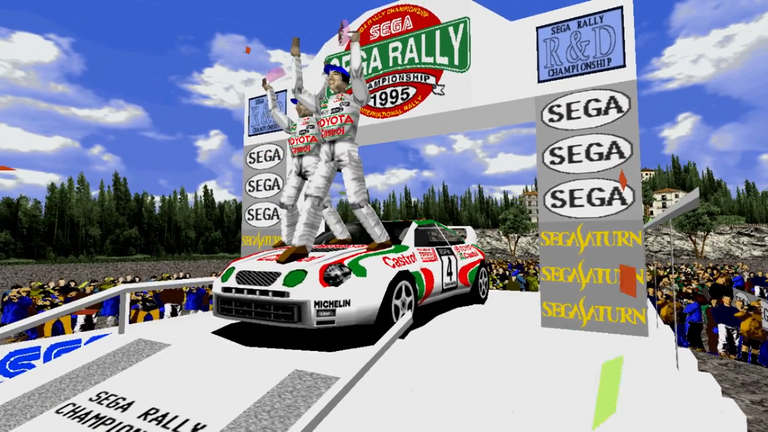
To end this post, I will leave below a gameplay from the legendary TEAM MARUBAKU, which was a team of SEGA arcade racing game experts that actually got established with the release and huge popularity of SEGA Rally Championship in the 90s. While I had posted a video of my own above as well in high-resolution (while this one is recorded from original hardware and at a lower quality), the runs recorded for this game and others on this channel from MARUBAKU are nothing short of impressive skills for these hidden gems, and the amount of control here left me quite amazed.
While I'd recommend playing with a gamepad with analog triggers if you have one for the best steering and pedal precision (I improved after being able to use a GC pad for my runs), I remember enjoying a lot the game even on keyboard because it was loose enough to work with digital steering. I hope that you enjoy this hidden gem!
Español -ESP-
Siempre he tenido debilidad por los juegos arcade de carreras de SEGA, teniendo en cuenta que Daytona USA 2 fue el primero que vi de niño en mi centro comercial local y que me atrapó al instante, para luego buscar sobre todos los demás juegos que SEGA había sacado. Uno de ellos sería el homónimo SEGA Rally Championship, conocido como una de sus mejores obras maestras en este ámbito junto con Daytona USA y OutRun.

Con el mismo hardware de arcade Modelo 2 utilizado para Daytona USA, SEGA Rally Championship salió a la venta en 1994 para Arcades y resultó ser el siguiente en la inusual tendencia de los juegos de carreras de SEGA con licencias que tuvieron mucho éxito (OutRun tenía el Ferrari, Daytona USA tenía el nombre, y este juego contaba con coches reales Toyota Celica GT-Four y Lancia Delta HF Integrale).

El juego tenía 3 pistas en bucle (más una cuarta oculta) y dos modos: Campeonato, en el que tienes que dar una vuelta a los tres circuitos (más el circuito extra de Lakeside), y Práctica, en el que das tres vueltas al circuito que elijas (el de Lakeside se puede seleccionar mediante una combinación de botones). El Campeonato es una nueva forma de jugar en todos los circuitos en un solo crédito/carrera, mientras que la Práctica te permite poner a prueba tus habilidades de contrarreloj en un circuito específico.

La jugabilidad es perfecta para un juego arcade, y cada terreno tiene una tracción de conducción diferente que era totalmente inédita para su época. Fácil de aprender pero difícil de dominar, el manejo es lo suficientemente indulgente como para divertirse en los circuitos del desierto y la montaña, pero tienes que emplear derrapes para las curvas medias, los giros en K y las horquillas, ya que hay un límite de tiempo que te presiona para terminar. Si aún no te has acostumbrado al juego, probablemente te quedarás sin tiempo en la pista de montaña hasta que practiques lo suficiente.

Hablando de práctica, a la pista del Lago mencionada anteriormente sólo se puede acceder si terminas con el primer puesto en la última pista, y pondrá a prueba tanto tu precisión con el volante como tu paciencia con el acelerador para mantener una velocidad constante pero evitando chocar con los bordes bastante finos de la pista.

Junto con los impresionantes gráficos de la época (que siguen manteniéndose bien cuando se actualizan) y la divertida jugabilidad, también está respaldado por un impresionante diseño de audio, con una voz de copiloto muy icónica que indica cada giro, y las composiciones de Takenobu Mitsuyoshi son de una energía de primera categoría, al igual que en Daytona. Con el increíble éxito que tuvo el juego en los salones recreativos y en los ports domésticos (Saturn y PC), incluso influyó en el diseño del primer juego de Collin McRae Rally, que dio lugar a una franquicia; aunque más centrada en una jugabilidad más realista y en pistas de sprint.
La premisa básica del juego se basaba en el manejo del coche en Sega Rally. A todos los que lo jugaron les encantó la forma en que los coches se comportaban en las diferentes superficies, especialmente el hecho de que podías deslizar el coche de forma realista en la grava suelta. El manejo de los coches sigue siendo excelente a día de hoy y sigue siendo una máquina arcade a la que disfruto jugando, si tengo la oportunidad.
Guy Wilday - Productor de los 4 primeros juegos de Colin McRae Rally
Al ser un éxito absoluto, recibió cuatro secuelas (SEGA Rally 2, SR2006, SR3/Online Arcade y Revo), pero lamentablemente ni éstas ni el original se pueden comprar en ningún sitio en las tiendas digitales, por lo que la emulación (que es lo que he utilizado para jugar al juego y las capturas de pantalla) es una buena forma de jugar a éstos (o de tener las consolas originales). Aparte de eso, es una gran recomendación de mi parte, ya que el juego sigue vigente hoy en día, y se puede jugar en ráfagas cortas debido a que fue hecho para arcades.

Para terminar este post, voy a dejar a continuación un gameplay del legendario TEAM MARUBAKU, que fue un equipo de expertos en juegos de carreras arcade de SEGA que se estableció con el lanzamiento y la enorme popularidad de SEGA Rally Championship en los años 90. Si bien ya había publicado un vídeo mío arriba en alta resolución (mientras que éste está grabado desde el hardware original y con una calidad inferior), las carreras grabadas para este juego y otros en este canal de MARUBAKU son nada menos que habilidades impresionantes para estas joyas ocultas, y la cantidad de control aquí me dejó bastante sorprendido.
Aunque recomendaría jugar con un gamepad con gatillos analógicos si tienes uno para obtener la mejor dirección y precisión de los pedales (yo mejoré después de poder usar un pad de GC para mis carreras), recuerdo haber disfrutado mucho del juego incluso con teclado porque el control era suficientemente leniente como para funcionar con la dirección digital. ¡Espero que disfrutes de esta joya oculta!